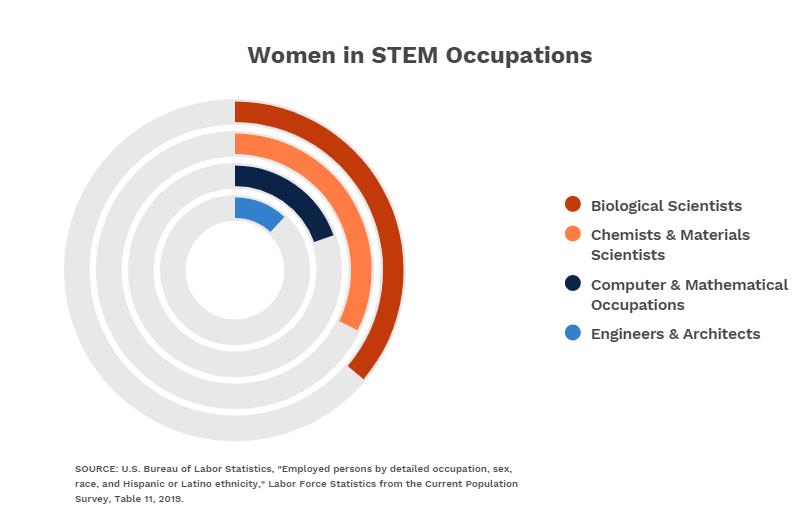It is a worldwide phenomenon that women have a low representation in STEM careers: namely Science, Technology, Engineering and Mathematics. Even in the developed countries like the USA and Australia, gender disparity in STEM is really high, fuelled even more by gender pay gap.
In the USA, on an average, women make up only 28% of the workforce in STEM careers. In addition to this, the gender gap is particularly high in the highest paying STEM jobs like Engineering and Computer Science..
A report from the U.S. Bureau of Labor Statistics claims that in 2019, out of all women in STEM, 47.7% of them had their career as a biological scientist, 42.5% as chemists and materials scientists, 25.8% in computer and mathematical occupations, and the remaining 15.7% as engineers and architects.
Where does Nepal Stand in this case?
In Nepal, the education system is still in the nascent phase with 67.9% adult literacy rate (2018). In this scenario, a mere participation of a woman in any of the STEM fields is a matter of celebration. And if she succeeds in creating an impact on society (even a tiny one), she’s invited in many talk shows and celebrated even in the international forums. This is really a good thing to inspire the young girls in considering their career into STEM fields.
However, when we see the numbers, gender disparity in STEM is wider in our country both in terms of university enrollment and career aspects. The IOE Entrance Exam Results show that the ratio of males to females who passed it accounts for 32:7. It means that on an average, every year out of the total enrollment in these IOE Campuses, only about 18% are females. If you see in the fields like Arts, Education and Management, about half of them are females.
Enrollment to Involvement: What Changes Occur Mostly in the Journey?
One of my friends who studied Industrial Engineering in IOE Thapathali Campus, told me that they had about 12 girls in their batch, and the number dropped to 9 in the middle of the course. While the universities are trying out ways to bring more women in STEM subjects, either through reservation quota or discount offers, none of them helps out.
And it does not account for male domination yet because the actual gender gap occurs in higher class leadership roles’ not in the entry levels. In addition to that, most of the colleges for Science and Engineering like IOE Pulchowk and Thapathali Campus have a reservation quota for girls in their enrollment for bachelors programs. Still the number is low. After all, it is a matter of personal choice, family constraints and social settings that play a major role in shaping the careers of females.
Cultural Setting: How is it Hindering Women’s Career in STEM?
In Nepal, the number of female students in STEM account more for biological science sector. And most importantly, we have a considerable number of females in courses like nursing and ANM. In 2017, there were already 71557 nurses who were enrolled in about 250 different programs combined, (Nursing Forum, 2017). And this has something to do with the cultural setting of our society.
The increasing number of girls in nursing courses is a result of stereotyping nursing as “female jobs”, while it is not true. We still feel awkward when a male is a nurse and still we keep calling “sisters” to female doctors. This is the problem of our educational system and it needs a long time to change this culture and accept that any profession is not gender specific. In other cases, people still doubt if a woman can make a robot or develop a software with higher accuracy, regardless of her ability.
The cultural stereotyping that hardcore jobs like engineering, software developments, data science and analysis are mostly suited for men is making women rethink their decision to join any STEM fields.

On this regard, Samikshya Kandel, Chief Secretary of Biotechnology Society of Nepal (BSN) and a Women in Science Awardee (WISA 2020) says,
” The thing that hinders the most in women’s decision pursuing STEM as career in Nepal is their dependency upon family for taking career decisions. Secondly, majority of the girls are engaged (in one way compelled for) in household chores that in totality keeps them away from giving best in their profession that decreases their efficiency. Some even drop out of their college or switch their careers because of marriage and other family issues.
I think I am really privileged in this because I was able to stand with the purpose of my life and I want to give back to community by empowering other girls in the lane.”
Driven by Purpose or Passion?
Careers like engineering, tech jobs, designing and web development, data analysis etc provide a higher pay scale as compared to others. Moreover, women’s innate ability to multitasking makes them more confident in STEM throughout the time as they get into an exploratory journey as a STEM graduate or a professional. In these circumstances, do women choose STEM fields as a career out of their passion or for a career safety?
To clear out this issue, I asked some of the women who have been successfully pursuing their career in STEM fields and creating an impact in the society.

In a clubhouse discussion, the CEO of Smart Cheli, Pratiskhya Pandey said that she was not exposed to computers at an early age. That was the hindrance because she didn’t know if she wanted to become a data engineer. While growing up, she got mentored by her relatives to pursue her career in STEM.

Adding on to this, Sonika Baniya, a software engineer said that she was really anxious and doubtful if she could make it that far in engineering. But once she joined it, the skills like problem solving, stress handling have developed much in her as a result of it, making her more confident.

Aayushma Pant added, ” As a data science and AI enthusiast, I love coding. But this passion didn’t existed before. I joined this field with no any clue after +2 but I really enjoyed coding and software development which has motivated me to continue the process .
Most of them agreed that they had an open view towards joining STEM subjects. But once they joined it, it became a passion with purpose so that they could be an example for many young girls who are still doubtful of their abilities in STEM.
Can We Get to See More Women in STEM in the Near Future?
Technology has played a vital role in accelerating the opportunities for people involved in STEM. Whether you’re a biological scientist or a data engineer, or even a mathematician, a know-how of technology can help you build a lucrative career. The gender disparity would always exist until and unless we start to normalize women’s participation in STEM.
Also Read: Women in Tech: Women who are paving the tech track of Nepal!
The school curriculum of our country has now identified the importance of computer science. Hence, it is a compulsory subject in the secondary levels now. Similarly, some high schools have initiated pre-engineering classes for science students in +2 levels. It has helped them explore about the scopes of it and have an enough time to decide if they can really pursue it. As most women agree, being involved in STEM field itself is an reward in a patriarchal society. And it further inspires them to prove themselves that they can lead better and break all those stereotypes that the society has shaped for them. With an increasing number of female leaders paving the way for younger ones in this path, I see the future is bright. And I’m really optimistic that we can see more women who themselves choose STEM as their core career.







